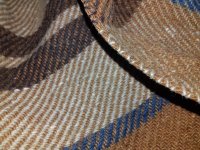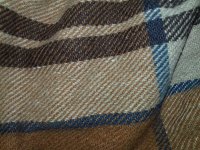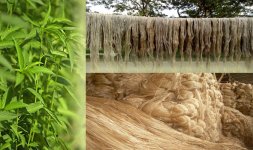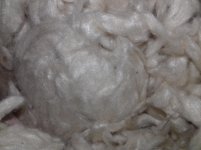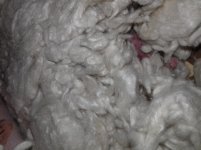Long haired wool is used for transmission lines, as it has good absorption tp quite low frequencies, as I understand it. But it sags and needs moth-proofing. Cotton, polyester, BAF, rockwool, etc, all have their uses, but I don't know enough about their different properties to offer advice.
There are very experienced speaker builders here who could advise you much better than I could.
There are very experienced speaker builders here who could advise you much better than I could.
If You are using fiberglass (itchy stuff) consider wrapping it in white thin felt.
Sewing shops usually carry this type of felt since it is used in shirt collars and bed-liners.
You can also use some sort of cloth for this. It's easier to staple and doesn't break apart.
Sewing shops usually carry this type of felt since it is used in shirt collars and bed-liners.
You can also use some sort of cloth for this. It's easier to staple and doesn't break apart.
And wear gloves while using fibreglass. Itches like crazy. Learnt it the hard way. Long time ago. Also I think not very good for health if not used properly. Check out the internet to understand how to use it safely.
Oon
Oon
Quite right, cellulose acetate fibres are distinct from, and more environmentally friendly than, polyester fibres.BAF is Bonded Acetate Fibre, not polyester.
The two are often blended together in fabrics because of their complementary properties.
What fullrange speaker do you plan to build? I made a Buschhorn based on these plans:
Hornlautsprecher von Jens Borowski
(Sorry, it is German where the original plans come from)
I used fiberglass or glass wool in the chamber behind the loudspeaker, but nothing in the folded horn part. It made a big difference, without stuffing it sounded "raw" and boomy.
Hornlautsprecher von Jens Borowski
(Sorry, it is German where the original plans come from)
I used fiberglass or glass wool in the chamber behind the loudspeaker, but nothing in the folded horn part. It made a big difference, without stuffing it sounded "raw" and boomy.
If You are using fiberglass (itchy stuff) consider wrapping it in white thin felt.
Sewing shops usually carry this type of felt since it is used in shirt collars and bed-liners.
You can also use some sort of cloth for this. It's easier to staple and doesn't break apart.
thnks for the advice. i'll use cloth made of cotton.
with fibreglass.
What fullrange speaker do you plan to build? I made a Buschhorn based on these plans:
Hornlautsprecher von Jens Borowski
(Sorry, it is German where the original plans come from)
I used fiberglass or glass wool in the chamber behind the loudspeaker, but nothing in the folded horn part. It made a big difference, without stuffing it sounded "raw" and boomy.
Nothing special. DIY you know.
10" Paper cone woofer from Sweton.
A trusted indian brand.
For amp- i have 3886, a good hifi preamp tone control
( yes i use tone controls 😎) & Cd player.
Last edited:
Hi everyone. Fiberglass is quite expensive here; I don't need that much though, have to buy a whole roll (USD$25)  😀
😀
Do you recommend woolen blanket for lining? i am not sure if it is made of cotton but it looks good 😛
Also i like to use 1inch thick open cell foam for rear side only, with blanket lining.
 😀
😀Do you recommend woolen blanket for lining? i am not sure if it is made of cotton but it looks good 😛
Also i like to use 1inch thick open cell foam for rear side only, with blanket lining.
Attachments
If only used to line the inner walls of the enclosure, it won't do any harm, and may do a little good.Do you recommend woolen blanket for lining?
Fill the enclosure with loose rolls of polyester fibre, that will do the most good.

Not much more to add (words or absorbent!) I would say. 😎
Ok this is my last Q. What do you think of using jute fiber for lining? I have plenty of that. With polyfill stuffing 😉
Jute fibre has sound insulation properties.
I would contemplate the use of jute fibre in its raw state for stuffing and, when woven into a mat or a cloth, as lining.
I would contemplate the use of jute fibre in its raw state for stuffing and, when woven into a mat or a cloth, as lining.
Attachments
Last edited:
Jute fibre has sound insulation properties.
I would contemplate the use of jute in its natural state for stuffing and, when woven into a mat or a cloth, as lining.
So it is good? 🙄 will it make box volume bigger? or just good for standing wave? i am ending this thread.
You are most welcome to return with a new one! 🙂i am ending this thread.
Used as I suggested, I imagine jute fibre will function just as well as polyester fibre in respect to absorbing the energy from the rear of the speaker cone and marginally increasing the perceived volume of the enclosure.
You are most welcome to return with a new one! 🙂
Used as I suggested, I imagine jute fibre will function just as well as polyester fibre in respect to absorbing the energy from the rear of the speaker cone and marginally increasing the perceived volume of the enclosure.
Thnk u 🙂
If you do end up with fiberglass, you can place it in old pillow cases. And, the other products you have brought forth will work as well. The idea of the stuffing is to turn the standing waves into heat. All of those products will do that. I think the wool will work better than jute, but that is just a guess.
If you do end up with fiberglass, you can place it in old pillow cases. And, the other products you have brought forth will work as well. The idea of the stuffing is to turn the standing waves into heat. All of those products will do that. I think the wool will work better than jute, but that is just a guess.
Hi, i discovered; i have plenty of this(Loose cotton, pillow type, more than 3kg). i want to use them with pillow cover made of long cotton fibre, at least 2inch thick glued to rear panel. My enclosure(sealed) is quite heavily braced, so my only concern is internal reflection. With loose cotton i am going to use cotton batting but of low quantity.
My question is how effective it would be? The QTC of my box is near 1. Do you recommend pillow cover for this?
Regards.
Attachments
Rock wool is exponentially more irritating in every way than fiber glass. I am a construction contractor and deal with these materials on a daily basis. I can assure you I know what I'm talking about here. Both materials will easily migrate throughout the hardware inside the cab but rock wool especially. Used in a bass reflex cab,both materials will be venting out the ports constantly. JBL used/uses a fiberglass batting with much longer fibers than that used for insulation purposes drastically minimizing the tendency to break away and fly off. On the LH forum there's a thread listing the code number and where to get it.Rock wool is better and not so itchy. You can get it at construction depos, where drywall is sold. Stuffing is good for closed box and horn, but not useful for bass reflex or damping plywood/MDF wall vibrations.
Owens Corning 703 is a rigid fiberglass specifically made for acoustic insulation
Last edited:
- Home
- Loudspeakers
- Full Range
- Fiberglass?
